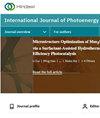Temperature Distribution Research on Liquid Packaging Structure of Deep UV LEDs
IF 2.1
4区 工程技术
Q3 CHEMISTRY, PHYSICAL
引用次数: 0
Abstract
By showing a packaged device model with chips, the effects of packaging material, device height, chip spacing, thermal conductivity, and viscosity of silicone oil on temperature distribution of deep ultraviolet (UV) light-emitting diodes (LEDs) were investigated by finite element simulation. The results showed that similar temperature distributions in the horizontal and vertical directions were obtained using different packaging materials including gas, solid, and liquid. The lowest maximum temperature (131.7°C) was obtained with liquid packaging compared to the gas packaging (140.8°C) and solid packing (132.5°C). Accompanied by increasing the device height, the maximum temperature of the liquid packaging structure revealed a more significant drop compared to solid packaging. However, that of gas packaging exhibited a rise and saturation. Larger chip spacing and higher thermal conductivity of silicone oil will dramatically reduce the maximum temperature of the liquid packaging device, and a lower maximum temperature and more uniform temperature distribution were obtained by using a lower viscosity packaging material. Therefore, considering the feasibility of the device process, appropriate liquid packaging structures can be optimized, and the maximum temperature of the liquid packaging structure of 102.8°C has been achieved. Liquid packaging may have a certain impact on the reliability of device sealing due to the current immature technology. For high-power light sources, there may also be a certain impact on their lifespan.深紫外led液体封装结构温度分布研究
通过采用芯片封装器件模型,采用有限元模拟方法研究了封装材料、器件高度、芯片间距、导热系数和硅油粘度对深紫外发光二极管(led)温度分布的影响。结果表明:不同包装材料(气体、固体和液体)在水平方向和垂直方向上的温度分布相似;与气体包装(140.8°C)和固体包装(132.5°C)相比,液体包装获得的最低最高温度(131.7°C)。随着器件高度的增加,液体包装结构的最高温度比固体包装结构的最高温度下降更为明显。而气体包装则呈现出上升和饱和的趋势。更大的芯片间距和更高的硅油导热系数会显著降低液体封装器件的最高温度,使用更低粘度的封装材料可以获得更低的最高温度和更均匀的温度分布。因此,考虑到器件工艺的可行性,可以优化合适的液体封装结构,实现了液体封装结构的最高温度102.8℃。由于目前技术不成熟,液体封装可能会对器件密封的可靠性产生一定的影响。对于大功率光源,也可能对其寿命有一定的影响。
本文章由计算机程序翻译,如有差异,请以英文原文为准。
求助全文
约1分钟内获得全文
求助全文
来源期刊
CiteScore
6.00
自引率
3.10%
发文量
128
审稿时长
3.6 months
期刊介绍:
International Journal of Photoenergy is a peer-reviewed, open access journal that publishes original research articles as well as review articles in all areas of photoenergy. The journal consolidates research activities in photochemistry and solar energy utilization into a single and unique forum for discussing and sharing knowledge.
The journal covers the following topics and applications:
- Photocatalysis
- Photostability and Toxicity of Drugs and UV-Photoprotection
- Solar Energy
- Artificial Light Harvesting Systems
- Photomedicine
- Photo Nanosystems
- Nano Tools for Solar Energy and Photochemistry
- Solar Chemistry
- Photochromism
- Organic Light-Emitting Diodes
- PV Systems
- Nano Structured Solar Cells

 求助内容:
求助内容: 应助结果提醒方式:
应助结果提醒方式:


